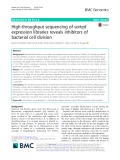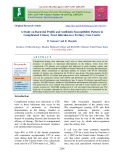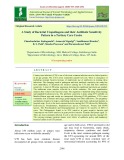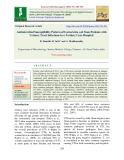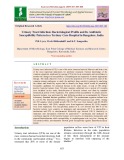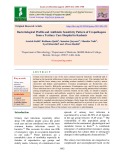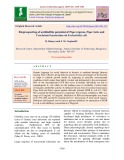
Uropathogenic E. coli
-
Bacterial filamentation occurs when rod-shaped bacteria grow without dividing. To identify genetically encoded inhibitors of division that promote filamentation, we used cell sorting flow cytometry to enrich filamentous clones from an inducible expression library, and then identified the cloned DNA with high-throughput DNA sequencing. We applied the method to an expression library made from fragmented genomic DNA of uropathogenic E. coli UTI89, which undergoes extensive reversible filamentation in urinary tract infections and might encode additional regulators of division.
 16p
16p  vitzuyu2711
vitzuyu2711
 29-09-2021
29-09-2021
 13
13
 1
1
 Download
Download
-
The study was carried out from January 2017 to June 2017 at the Microbiology Diagnostics and Infection Control Unit at the Medical Microbiology and immunology Department, Faculty of Medicine, Mansoura University.
 9p
9p  trinhthamhodang1218
trinhthamhodang1218
 26-02-2021
26-02-2021
 6
6
 1
1
 Download
Download
-
The main aim of this study to determine the Bacteriological profile in patients with Complicated Urinary Tract Infection and determine the Antibiotic susceptibility pattern using Kirby Bauer Disc diffusion method. Also identify the prevalence of ESBL in E. coli and Klebsiella spp by screening and phenotypic confirmatory methods. Finally, analyse the drug resistant pattern in uropathogens in cUTI.
 9p
9p  gaocaolon9
gaocaolon9
 22-12-2020
22-12-2020
 18
18
 2
2
 Download
Download
-
A study of bacterial uropathogens and their antibiotic sensitivity pattern in a tertiary care centre
Urinary tract infection (UTI) is one of the most common infection seen in clinical practice in all age groups. The UTI is most commonly caused by E.coli. There is emergence of multidrug resistant bacteria because of inadvertent use of antibiotics in treating these infections. The changing trend of pathogens and their antibiotic sensitivity the study has been undertaken, to determine the bacteria causing the UTI and find their antibiotic sensitivity. A total of 200 urine specimens showing the significant bacteriuria are studied. The midstream urine samples collected in a sterile container.
 5p
5p  trinhthamhodang9
trinhthamhodang9
 16-12-2020
16-12-2020
 9
9
 1
1
 Download
Download
-
Urinary tract infection (UTI) is considered as the most common bacterial infectious disease seen among the pediatric patients. Pediatric urinary tract infections are associated with high morbidity and long term complications like renal scaring, hypertension and chronic renal failure The epidemiology of UTI during childhood varies by age, gender and other factors (Bickerton and Ducket, 1985). Most commonly bacteria causes of UTI in children are members of Enterobacteriaceae, particularly uropathogenic strains of E. coli and Klebsiella spp.
 11p
11p  nguaconbaynhay5
nguaconbaynhay5
 11-05-2020
11-05-2020
 21
21
 1
1
 Download
Download
-
Urinary tract infection (UTI) is one of the most common bacterial infections in humans after respiratory tract infection. E.coli remains the leading uropathogen being responsible for UTI. The aim of the study is to assess the resistance pattern of E.coli causing UTI to commonly used antibiotics, so as to aid the clinician in changing the appropriate antimicrobial empirical therapy. E.coli isolated from urine samples were identified by conventional biochemical test. Antimicrobial susceptibility test was done by Kirby–Bauer disc diffusion method on Mueller–Hinton agar.
 6p
6p  trinhthamhodang4
trinhthamhodang4
 22-03-2020
22-03-2020
 21
21
 2
2
 Download
Download
-
Urinary tract infection (UTI) is one of the most common bacterial illnesses and hence one of the most important indications for antibiotic treatment. Current knowledge of the common organisms implicated in causing UTI in the local community and surveillance to monitor the changes in susceptibility of uropathogens are imperative to ensure appropriate therapy.
 8p
8p  trinhthamhodang3
trinhthamhodang3
 12-02-2020
12-02-2020
 13
13
 1
1
 Download
Download
-
Urinary tract infection is one of the most common bacterial infections worldwide and is defined as the bacterial infiltration of otherwise sterile urinary tract. This includes both the upper and the lower urinary tract including urethra (urethritis), bladder (cystitis), ureters (ureteritis) and kidney (pyelonephritis). Common uropathogens are Escherichia coli, Enterococcus faecalis, Klebsiella pneumonia, Pseudomonas spp. and Proteus mirabilis. These infections have risk of high recurrence rates and increasing antimicrobial resistance among uropathogens has enhanced economic burden.
 9p
9p  kethamoi2
kethamoi2
 15-12-2019
15-12-2019
 27
27
 1
1
 Download
Download
-
Genetic language for social behavior in bacteria is mediated through Quorum sensing. This collective group behavior posses obvious advantages for the bacteria to adapt to suitable growth modes by migrating to amicable environmental conditions which makes them highly virulent and detrimental to the environment. 80% of the uncomplicated UTIs that occur in healthy individuals are due to uropathogenic E. coli which are the leading cause of morbidity.
 15p
15p  nguaconbaynhay1
nguaconbaynhay1
 04-12-2019
04-12-2019
 21
21
 1
1
 Download
Download
CHỦ ĐỀ BẠN MUỐN TÌM








